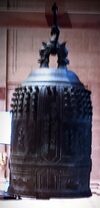SUNDAY, DECEMBER 31 Asian Art Museum San Francisco Ring in the New Year by taking a swing at a 2,100-pound, 16th-century Japanese temple bell. Led by Reverend Gengo Akiba, this inspiring ceremony will include a purification ritual and chanting of the Buddhist Heart Sutra. Visitors will have an opportunity to ring the bell to leave behind any unfortunate experiences, regrettable deeds, or ill luck from the year. The bell will be struck 108 times to usher in the New Year and curb the 108 mortal desires (bonno) that, according to Buddhist belief, torment humankind.

The bell was made by Tachibana Kyubei for Daienji Temple in Tajima province, Japan, in 1532. Inscriptions on the bell include Buddhist texts and information about the bells creation such as the artist's name, date, and temple name. The AAM acquired the bell in 1984.
The following verses are in raised text alongside the figures of the four guardians kings of the east, south, west, and north in the four squares that surround the bell. They come from the Nirvana Sutra and express the essence of that text.
All things lack permanence
This is the law of birth and death
Extinguish birth and death
Cessation leads to bliss
Larger inscriptions appear in raised text on the front and back of the bell in a single vertical line.
Praise Amitabha Buddha
Praise Avalokiteshvara Bodhisattva
This text is carved into the bronze on the right side of the bell.
We vow to confer our merit on all beings equally.
May one and all attain awakened mind, be born in the land of bliss.
This is chanted after the reading a sutra aloud. Reading the sutra creates merit and this invocation passes the merit on to other beings who are suffering so they can attain liberation.
translation/description by Melissa Rinne (AAM)
The Heart Sutra
The Bodhisattva of Compassion, When he meditated deeply, Saw the emptiness of all five skandhas
(form, sensation, perception, mental activity or formations, consciousness)
And sundered the bonds that caused him suffering.
Here then, Form is no other than emptiness, Emptiness no other than form.
Form is only emptiness, Emptiness only form.
Feeling, thought, and choice, Consciousness itself, Are the same as this.
All things are by nature void They are not born or destroyed Nor are they stained or pure Nor do they wax or wane
So, in emptiness, no form, No feeling, thought, or choice,
Nor is there consciousness. No eye, ear, nose, tongue, body, mind;
No colour, sound, smell, taste, touch, Or what the mind takes hold of, Nor even act of sensing.
No ignorance or end of it, Nor all that comes of ignorance; No withering, no death, No end of them.
Nor is there pain, or cause of pain, Or cease in pain, or noble path To lead from pain;
Not even wisdom to attain! Attainment too is emptiness.
So know that the Bodhisattva Holding to nothing whatever, But dwelling in Prajna wisdom,
(understanding of the true nature of phenomena)
Is freed of delusive hindrance, Rid of the fear bred by it, And reaches clearest Nirvana.
All Buddhas of past and present, Buddhas of future time,
Using this Prajna wisdom, Come to full and perfect vision.
Hear then the great dharani, The radiant peerless mantra, The Prajnaparamita Whose words allay all pain;
Hear and believe its truth! Gate Gate Paragate Parasamgate Bodhi Svaha
Gate Gate Paragate Parasamgate Bodhi Svaha
Gate Gate Paragate Parasamgate Bodhi Svaha

